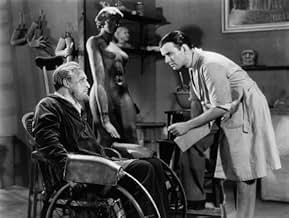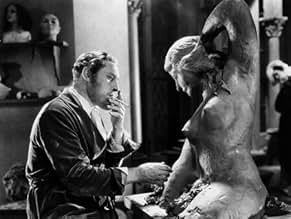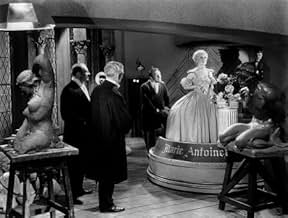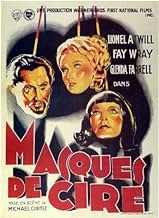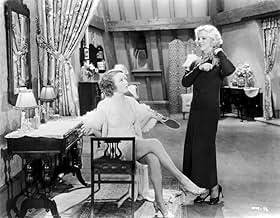CALIFICACIÓN DE IMDb
6.8/10
7.2 k
TU CALIFICACIÓN
En un museo de cera, un curador enmascarado transforma a la gente en estatuas y busca a su siguiente María Antonieta.En un museo de cera, un curador enmascarado transforma a la gente en estatuas y busca a su siguiente María Antonieta.En un museo de cera, un curador enmascarado transforma a la gente en estatuas y busca a su siguiente María Antonieta.
- Dirección
- Guionistas
- Elenco
Thomas E. Jackson
- Detective
- (as Thomas Jackson)
Bull Anderson
- Janitor
- (sin créditos)
Frank Austin
- Winton's Valet
- (sin créditos)
Max Barwyn
- Museum Visitor
- (sin créditos)
Wade Boteler
- Ambrose
- (sin créditos)
- Dirección
- Guionistas
- Todo el elenco y el equipo
- Producción, taquilla y más en IMDbPro
Opiniones destacadas
She has been so sorely maligned. Despite what has been claimed by others here, Glenda Farrell was not a bad actress. A little broad sometimes perhaps, but not bad. She is a dynamo of live energy, which the film badly needs, for the only other energetic character in the film is Atwill, and only Farrell has the force to bring him down(that the script does not let her do so personally betrays the character). It is not Farrell's performance or even her character which is the problem of the film, but the script which makes that character necessary. Chock Full O' undeveloped characters (only Atwill and Farrell qualify as more than ciphers)whose paths cross coincidentally,Farrell's reporter is the one in the middle bringing the disparate elements together. A reporter or policeman had to be the central character, for only one of those two would be privy to all or even enough of the info needed to solve the puzzle, or to even recognize that the puzzle existed. And only a female reporter could be Fay Wray's roommate, as female police detectives or beat cops didn't exist(at least not in Hollywood). And only a fast-talking, wisecracking, brash and fierce female reporter able to beat the stereotypical fast-talking, wisecracking, brash 1930's male reporter at his own game could find the story AND crack the case before the police. Others have objected to the attention given the comic relief, apparently misunderstanding the term. Comic relief characters are supporting characters, and in this film, despite third billing, Glenda Farrell is the female lead. Fay Wray was a freelancer and able to negotiate better billing even though her role doesn't deserve it. Had she not had a real lead in the companion film DR.X, it's unlikely she would have been asked to take such a small part. Charlotte is needed in the story only for a face, and her face and scream are all Wray is allowed to bring to the role. As outstanding as those two attributes are, they don't add up to a real character. And while Farrell cracks wise, she is doing serious work central to the tale. A role with comedic content is not automatically a comic relief part. The script is a mess, letting down the great concept. HOUSE OF WAX is a much tighter script, more linear, combining ingenue and snoop into one role, and beefing up the part of the disfigured sculptor. It drops the very extraneous playboy character and the loose ends which trail in his wake. But most agree that HOUSE is boring compared to MYSTERY, and in addition to the direction and editing, much of MYSTERY's drive comes from the girl reporter and the crack actress who played her. Even if you do find her grating, Glenda Farrell is never boring.
These days, Mystery of the Wax Museum has become best known for the fact that it was the film that spawned the 1953 classic starring Vincent Price. This is somewhat unfair, however, as although this film isn't a brilliant masterpiece, or even genre classic, it has a right to remembered in it's own right. The film is actually quite daring and inventive for the time when it was made; and despite the fact that nothing too bad is graphically shown, for obvious reasons, some of the imagery on display does actually succeed in being quite disturbing. Take the deformed face of the central character for example; it won't keep you up all night, but considering the time when this was made; the effects are good. The two-strip Technicolor style of the film gives it something of a unique feel; and this again is to it's credit as the film has aged really, really well. The plot line will be familiar to anyone who has seen the Vincent Price version, but here, aside from a museum proprietor that gets his life work melted away in an inferno; we've got a press investigation into the affairs as well.
Lionel Atwill takes the lead role as the unfortunate victim of the flames, and while he's certainly no Vincent Price; he does well with what he's got and helps to create a macabre surrounding around his character, which in turn helps the film in the atmosphere department. Joining him are Glenda Farrell and Fay Wray as the heroine's of the story. Wray plays the girl that the unfortunate artist becomes obsessed with, and Farrell gives a slightly irritating, but very lively performance as a journalist. Both do well with their roles, and although this film isn't exactly an exhibition in acting (unlike Curtiz's masterpiece, Casablanca); the cast do well enough. One thing that is unfortunate for this film is that it's seen as a second feature for the Price version, which will harm what some viewers think of it as the plot elements are very similar to the 1953 film, so it can, at times, feel as though you're simply watching the same film again. However, if viewed as a stand-alone product, Mystery of the Wax Museum represents a solid 30's horror movie and I can see why any horror fan wouldn't enjoy it.
Lionel Atwill takes the lead role as the unfortunate victim of the flames, and while he's certainly no Vincent Price; he does well with what he's got and helps to create a macabre surrounding around his character, which in turn helps the film in the atmosphere department. Joining him are Glenda Farrell and Fay Wray as the heroine's of the story. Wray plays the girl that the unfortunate artist becomes obsessed with, and Farrell gives a slightly irritating, but very lively performance as a journalist. Both do well with their roles, and although this film isn't exactly an exhibition in acting (unlike Curtiz's masterpiece, Casablanca); the cast do well enough. One thing that is unfortunate for this film is that it's seen as a second feature for the Price version, which will harm what some viewers think of it as the plot elements are very similar to the 1953 film, so it can, at times, feel as though you're simply watching the same film again. However, if viewed as a stand-alone product, Mystery of the Wax Museum represents a solid 30's horror movie and I can see why any horror fan wouldn't enjoy it.
In the early 1930's Jack Warner was under contract to use the Two-strip technicolor process on a Warner Brothers film. Unfortunately, this primitive form of color cinematography had a limited pallet of colors. Everything had an unnatural pastel look. Warner wisely choose a genre not dependent on reality- the horror film. Their first color horror film was DOCTOR X, a wild and macabre who-dunnit complete with scary murders, truly mad doctors and a cannibal. DOCTOR X, released in 1932, was enough of a success, that Warner Brothers reunited it's director, Michael Curtiz, the two leads, Lionel Atwill and Fay Wray, and the two strip Technicolor process for yet another horror film. The new film, simply titled WAX MUSEUM during production was a fast moving creepy chiller that mixed the gloom of Depression era New York with the creepy going-ons of a wax museum. The film begins in 1921. Sculptor Ivan Igor (a bohemian looking Lionel Atwill), so obsessed creating his wax museum, that he ignores that he and his partner, Worth (Edwin Maxwell) are in deep financial trouble. Worth sets fire to the museum to collect on a fire insurance policy. The museum is destroyed, and Igor is left a cripple with useless hands.
Twelve years later, in Manhattan, Igor opens a new wax museum. At the same time, a wisecracking reporter, Florence (Glenda Farrell) tracks a hot case of the corpse of a recently murdered socialite stolen from the morgue. She begins to suspect that creepy wax museum downtown of stealing bodies and posing them as wax statues. What makes things worse, is that her best friend, Ruth (Fay Wray) is dating the most innocent of the questionable wax-workers. THE MYSTERY OF THE WAX MUSEUM is a DVD shelf must-have.
Twelve years later, in Manhattan, Igor opens a new wax museum. At the same time, a wisecracking reporter, Florence (Glenda Farrell) tracks a hot case of the corpse of a recently murdered socialite stolen from the morgue. She begins to suspect that creepy wax museum downtown of stealing bodies and posing them as wax statues. What makes things worse, is that her best friend, Ruth (Fay Wray) is dating the most innocent of the questionable wax-workers. THE MYSTERY OF THE WAX MUSEUM is a DVD shelf must-have.
Michael Curtiz has over 170 directing credits, including "The Jazz Singer." Of the films on that list which I have seen, this is my favourite. It's filled with some quite amazing dolly and camera work, the story is fun and the acting is solid.
This story has had a long life. This film, was based on a play. In 1953, it was re-made as a Vincent Price vehicle, "House of Wax" in 3-D. And in 2005, it was re-made again as a teen slasher. The premise is solidly creepy.
Glenda Farrell is hilarious as the young journalist. Her energy leaps off the screen. I guess audiences of 1933 needed quite a bit of comic relief to make it through the rest of this.
Lionel Atwill's make-up is fantastic. It's no surprise that it was designed by a Westmore: Hollywood's premiere make-up family.
This was shot in a two-colour Technicolor process which makes the entire film rather distinctive and moody. The fantastic film noir lighting adds to it as well.
If you can find this, it's a definite must-see! There are so many images and ideas borrowed from it in later horror films it's interesting to see their origins.
This story has had a long life. This film, was based on a play. In 1953, it was re-made as a Vincent Price vehicle, "House of Wax" in 3-D. And in 2005, it was re-made again as a teen slasher. The premise is solidly creepy.
Glenda Farrell is hilarious as the young journalist. Her energy leaps off the screen. I guess audiences of 1933 needed quite a bit of comic relief to make it through the rest of this.
Lionel Atwill's make-up is fantastic. It's no surprise that it was designed by a Westmore: Hollywood's premiere make-up family.
This was shot in a two-colour Technicolor process which makes the entire film rather distinctive and moody. The fantastic film noir lighting adds to it as well.
If you can find this, it's a definite must-see! There are so many images and ideas borrowed from it in later horror films it's interesting to see their origins.
Classic horror movie directed by Michael Curtiz and starring Lionel Atwill as a deranged sculptor with an "interesting" method of making the statues on display at his wax museum. The last (and best) of the three horror movies Lionel Atwill did with Fay Wray. Atwill is fantastic here and Wray is, as always, delightful. Nice support from Frank McHugh, Gavin Gordon, and Edwin Maxwell, among others. The scene stealer of the movie is Glenda Farrell as the fast-talking reporter heroine. She really has fun with the part. A few years later she would star in the Torchy Blane series and play a character very similar to the one she plays here.
It's a good-looking movie, filmed in two-color Technicolor with nice atmospheric direction from Curtiz. The sets are great, especially Atwill's art deco laboratory. The makeup effects are terrific. It's a juicy Pre-Coder, as evidenced by the gruesome plot and the junkie character played by Arthur Edmund Carewe. Some viewers might be put off by the fact that a large chunk of the middle of the picture is more like a crime story/newspaper movie but I was always entertained, particularly by the back & forth between Farrell and McHugh. So it's not a straight horror movie from beginning to end but, so what, it's still a great film and worth a look. Remade in the '50s as House of Wax with Vincent Price. That version is more well-known than this one but I like rewatching this one more. It's just more fun.
It's a good-looking movie, filmed in two-color Technicolor with nice atmospheric direction from Curtiz. The sets are great, especially Atwill's art deco laboratory. The makeup effects are terrific. It's a juicy Pre-Coder, as evidenced by the gruesome plot and the junkie character played by Arthur Edmund Carewe. Some viewers might be put off by the fact that a large chunk of the middle of the picture is more like a crime story/newspaper movie but I was always entertained, particularly by the back & forth between Farrell and McHugh. So it's not a straight horror movie from beginning to end but, so what, it's still a great film and worth a look. Remade in the '50s as House of Wax with Vincent Price. That version is more well-known than this one but I like rewatching this one more. It's just more fun.
¿Sabías que…?
- TriviaThis film was produced before the Production Code. When it was remade 20 years later, as Los crímenes del museo de cera (1953), all references to drug use were removed, and a character was changed from a junkie to an alcoholic.
- ErroresIvan Igor says that Jean Paul Marat's assassin, Charlotte Corday, was his mistress. This is incorrect; they never had met until she came to his office posing as a courier and quickly stabbed him to death. After her execution a few days later, she was found to be virgo intacta.
- Versiones alternativasThis film was shot in two versions. One camera unit shot the film in two-color Technicolor. A second camera unit shot the scenes at the same time in black and white. The black and white version was meant for theaters who could not afford the higher rental cost of the color prints.
- ConexionesEdited into Mame (1974)
Selecciones populares
Inicia sesión para calificar y agrega a la lista de videos para obtener recomendaciones personalizadas
Detalles
- Fecha de lanzamiento
- País de origen
- Idioma
- También se conoce como
- The Mystery of the Wax Museum
- Locaciones de filmación
- Productora
- Ver más créditos de la compañía en IMDbPro
- Tiempo de ejecución1 hora 17 minutos
- Relación de aspecto
- 1.37 : 1
Contribuir a esta página
Sugiere una edición o agrega el contenido que falta

Principales brechas de datos
By what name was Mystery of the Wax Museum (1933) officially released in India in English?
Responda

